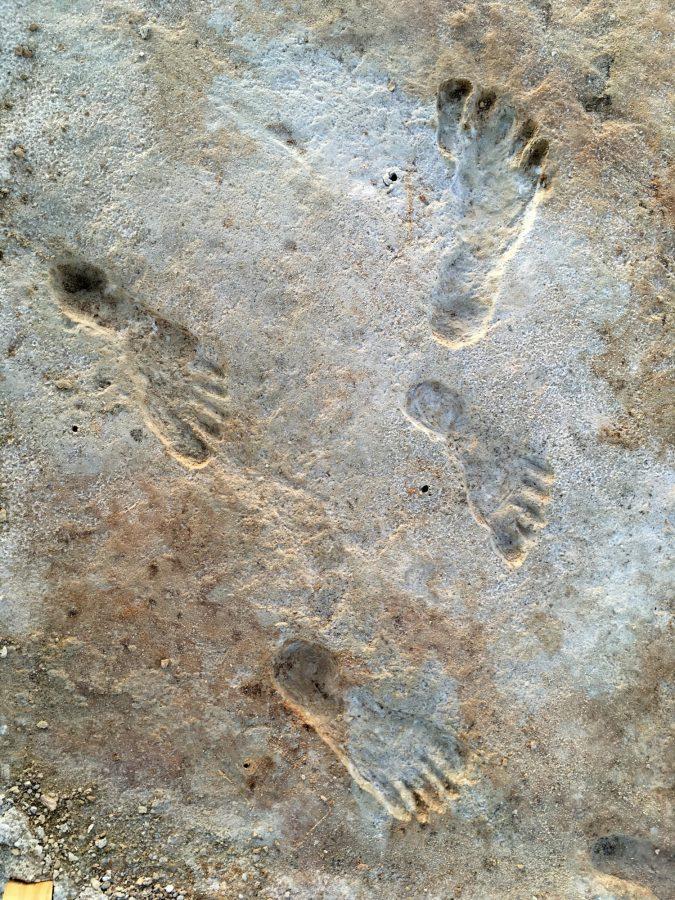In the White Sands National Park in New Mexico, archeologists and experts analyzed the discovery of human footprints near Lake Otero that was dated up to 23,000 years old. These footprints could change the timeline of when it is believed humans first inhabited North America.
According to a Science journal article, these tracks suggest humans were in the Americas up to 10,000 years before the Clovis people. These dates come from the stratigraphy of the footprints and radiocarbon dating of the seed layers within the footprints as well.
The article was co-authored by Vance Holliday, University of Arizona professor in the School of Anthropology and Department of Geosciences, as well as his field assistant and UA doctoral student in the Department of Geosciences, Brendan Fenerty, both of whom had done geoarchaeological research near the site in the past. Although, both did not get out to the site until after the excavations had already finished.
“It was that spring break when COVID-19 hit and … I saw the layers and I saw the footprints and I knew how old the site was based on the dating we had done two years before, but we didn’t know we had footprints, we were just doing the geologic work. It was this instant realization of ‘Holy cow!’, we have a 20,000 year old site,” Holliday described in the retelling of his first encounter with the site.
RELATED: A hidden forest on campus: Inside the Laboratory of Tree-Ring Research
There are criticisms of the data presented in the article, which have already been submitted to the Science journal even though the site proves to be important and not easily dismissed by people like Holliday.
“The conventional wisdom has been, for the most part and based on the data, that people didn’t get into the Americas until … that glacial ice started to melt. Then people started to come down from the interior of Alaska into central North America or along the coast from what was part of Alaska … or both,” Holliday stated.
As defined in the fourth edition of “The Human Past: World Prehistory and The Development of Human Societies” by Chris Scarre, the Last Glacial Maximum was a period thought to be roughly 21,000 years ago in which the sea level dropped due to a large number of ice sheets created. This ice sheet is theorized to have connected Asia to North America via the Bering Strait or along the pacific coast.
However, as also specified by Scarre, it is thought that no viable route opened for people to cross into North America until about 13,000 years ago when the Ice Corridor formed. This theory is backed up by the numerous artifacts, most predominantly arrowheads, found in the Americas during this time. The people believed to have left these artifacts are referred to commonly as the Clovis people.
RELATED: UA researches using swarms of robots to mine on moon’s surface
Holliday has his own theories on why there are so few archeological sites, like the footprints found by Lake Otero, that suggest humans made it to the Americas before the Clovis people.
“There is just not many of these really early sites. If you dug into the literature and drudged up all of the proposed older than Clovis sites, you’re dealing with maybe a couple of dozen from North and South America. Clovis is all over the place … To me, what we might be looking at is groups of people who arrived in the Americas at different times before Clovis and for whatever reasons the populations didn’t survive,” Holliday explained.
Holliday went on further to say that the footprints found by Lake Otero are not the only known to the White Sands National Park.
Another vital member of the discovery was Matthew R. Bennett, who has authored multiple papers related to dating tracks of all kinds and works at the Institute for Studies in Landscapes and Human Evolution at Bournemouth University. Bennet has found and researched other tracks present at the White Sands National Park, which have also received attention from the media and are considered by Holiday as another interesting testament to the people who were present there.
In a paper titled, “Walking in mud: Remarkable Pleistocene human trackways from White Sands National Park (New Mexico)” by Bennett, et all., footprints showed a mother possibly picking up and putting her child down as they were walking in a form of playing.
Holliday thinks the tracks found in the White Sands National Park are important “snapshots” of moments 20,000 years ago and is happy to see that the ones found by Lake Otero are making waves in the archeology world.
Follow Trinity Clark on Twitter









